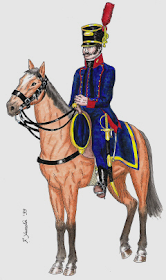 |
| The Almanza Dragoon Regiment, one of the units that was part of the Spanish 2nd Cavalry Division |
http://jjwargames.blogspot.co.uk/2015/02/the-army-of-estremadura-at-talavera-1809.html
As the build up of the project was all about creating smaller scenarios that would facilitate games with the collection as it grew, I started with General Portago's 3rd Division that was significantly engaged in the afternoon of the 28th July by General Laval's German Division and became a major part of the "Attack on the Pajar Vergara" the last game of which featured at this year's Legionary Show in Exeter and appeared in Miniature Wargames Magazine the following month.
http://jjwargames.blogspot.co.uk/2015/04/spanish-3rd-division-talavera.html
 |
| The map illustrates the position of the northern valley forces (left) and the Spanish forces deployed to support the Cerro de Medellin |
These forces consisted of General Bassecourt's 5th Infantry Division of mainly Spanish line infantry and Marines and General Albuquerque's 2nd Cavalry Division that swung in behind the British cavalry under Generals Anson and Fane (see the map above).
 |
| Luis Alejandro de Bassecourt commanding the Spanish 5th Infantry Division |
Real Marina (Royal Marines), lst Infantry Regiment (2 Battalions)
3/Africa Infantry Regiment
Murcia Infantry Regiment (2)
l/Reyna Infantry Regiment
Provincial de Siguenza (Militia) (l)
 |
| José María de la Cueva, 14th Duke of Albuquerque and commander of the Spanish 2nd Cavalry Division at Talavera |
2nd Division: Lieutenant-General Duquede Albuquerque - Source Oman
Carabineros Reales (l Squadron)
Infante Cavalry Regiment
Alcantara Cavalry Regiment
Pavia Cavalry Regiment
Almanza Cavalry Regiment
lst Hussars of Estremadura
2nd Hussars of Estremadura
 |
| Carabineros Reales |
 |
| Infante Heavy Cavalry Regiment |
 |
| Pavia Regiment of Dragoons |
Battle of Medellín 28th March 1809
 |
| Alcantara Heavy Cavalry Regiment |
So what can be said about the cavalry arm in General Cuesta's army at Talavera with any degree of certainty other than the units recorded on the order of battle, and even on that point I have found some digression.
Most of the sources seem to determine the total amount of cavalry in the two Spanish divisions as numbering around 6-7,000 men and horses. Some of the units were regiments in name only with units such as the Carabineros Reales only fielding one squadron and the two regiments of Estremaduran Hussars reported to have had variously 4-6 squadrons.
Even the look of these units has to speculative given the state of Spanish arms and supplies at this time and the losses suffered in March at Medellin.
 |
| Estremaduran Hussars |
This total number of 2,500 men is split between effectively five full regiments or twenty squadrons and has the Estremaduran Hussars amalgamated into one unit of four squadrons and sees the squadron of Carabineros Reales being attached out to the other regiments of dragoons and heavies at a generic four squadrons. This plan effectively has an average squadron strength of about 125 men each which looks about right.
These five regiments are pictured here in this post and will form the basis of the look of my units given all the caveats on precisely how reliable that look is.
Several sources suggest the single four gun horse battery that was with Cuesta's army was also attached to the 2nd Cavalry Division when it was detached to Wellesley's left flank, being positioned alongside the Spanish half battery of 12 lbrs on the Cerro de Medellin with the British guns, and so I will add the Spanish gun teams at a later stage for completeness.
 |
| Spanish Horse Artillery |
References consulted for this post
http://www.eborense.es/batalla_talavera1809_indice.html
Talavera, Wellington's First Victory in Spain - Andrew W Field
Great Battles in History Refought - Talavera, Partidge & Oliver
Talavera 1809, Wellington's Lightning Strike into Spain - Chartrand & Turner (Osprey Campaign)
Sir Charles Oman - History of the Peninsular War.

Sorting out the Spanish establishments is a right pain in the ..... we are having much the same problems. Good luck.
ReplyDeleteTony.
Hi Tony, yes an interesting challenge. I would love to see an equivilent of the Otto Manuscript done by some previously unknown artist as he sat in the streets of Talavera sketching and finishing off some watercolour illustrations of what these units actually looked like rather than the pattern book illustrations we have to content ourselves with.
DeleteEvery wargame unit I see of the Spanish tends to have the typical on parade look and I really want to create a more likely on campaign appearance, with that typical shabby adapted dress code that soldiers throughout history have adopted in the field.
I think the illustrations by Bob Marrion are really good at that. I might treat myself to his and Charles Grant's book on the Talavera campaign for inspiration.
Can hardly wait! I will be shadowing your posts for sure as I pull together my own Spanish.
ReplyDeleteThanks Bill I've been looking forward myself to getting back to the Spanish, so I hope you enjoy the series of posts.
DeleteWhat, no white ?
ReplyDeleteVince
Surely you embrace the concept of delayed gratification. First the donkey wallopers then wall to wall white with a splash on blue and brown.
DeleteI am glad you do this research - it makes life a lot easier for lazy people like myself. Thanks very much!!
ReplyDeleteI am looking at some of the same units in 28mm.
Cheers
Brian
It's a pleasure Brian so I might as well share and multiply the fun. I hope you enjoy the next few posts.
DeleteCheers
JJ
Just reading a history of the peninsula war, it's a really useful resource your putting together, thank you very much!
ReplyDeleteBest Iain
Hi Iain, thank you, really appreciate your comment.
DeleteJJ